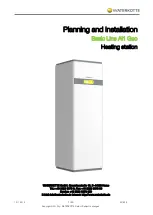
Fig. 1
3.1.2.
LEAKAGE CURRENT HOT CHECK (See Figure 1.)
1. Plug the AC cord directly into the AC outlet. Do not use an isolation transformer for this check.
2. Connect a 1.5k
Ω
, 10 watts resistor, in parallel with a 0.15µF capacitor, between each exposed metallic part on the set and a
good earth ground such as a water pipe, as shown in Figure 1.
3. Use an AC voltmeter, with 1000 ohms/volt or more sensitivity, to measure the potential across the resistor.
4. Check each exposed metallic part, and measure the voltage at each point.
5. Reverse the AC plug in the AC outlet and repeat each of the above measurements.
6. The potential at any point should not exceed 0.75 volts RMS. A leakage current tester (Simpson Model 229 or equivalent) may
be used to make the hot checks, leakage current must not exceed 1/2 milliamp. In case a measurement is outside of the limits
specified, there is a possibility of a shock hazard, and the equipment should be repaired and rechecked before it is returned to
the customer.
4 Handling the Lead Solder
4.1. About lead free solder (PbF)
Distinction of PbF P.C.B. :
P.C.B.s (manufactured) using lead free solder will have a PbF stamp on the P.C.B.
Caution:
·
Pb free solder has a higher melting point that standard solder; Typically the melting point is 50 - 70°F (30 - 40°C) higher.
Please use a high temperature soldering iron. In case of the soldering iron with temperature control, please set it to 700 ± 20°F
(370 ± 10°C).
·
Pb free solder will tend to splash when heated too high (about 1100°F/600°C).
·
When soldering or unsoldering, please completely remove all of the solder on the pins or solder area, and be sure to heat the
soldering points with the Pb free solder until it melts enough.
5 Protection Circuitry
The protection circuitry may have operated if either of the following conditions are noticed:
·
No sound is heard when the power is turned on.
·
Sound stops during a performance.
The function of this circuitry is to prevent circuitry damage if, for example, the positive and negative speaker connection wires are
“shorted”, or if speaker systems with an impedance less than the indicated rated impedance of the amplifier are used.
If this occurs, follow the procedure outlines below:
1. Turn off the power.
2. Determine the cause of the problem and correct it.
3. Turn on the power once again after one minute.
Note :
When the protection circuitry functions, the unit will not operate unless the power is first turned off and then on again.
6
SA-HT535E / SA-HT535EG
Summary of Contents for SA-HT535E
Page 12: ...10 Remote Control Reference 12 SA HT535E SA HT535EG ...
Page 13: ...11 Disc information 13 SA HT535E SA HT535EG ...
Page 14: ...14 SA HT535E SA HT535EG ...
Page 15: ...15 SA HT535E SA HT535EG ...
Page 16: ...16 SA HT535E SA HT535EG ...
Page 17: ...17 SA HT535E SA HT535EG ...
Page 20: ...Conventional HighMat 20 SA HT535E SA HT535EG ...
Page 32: ...16 2 P C B Locations 32 SA HT535E SA HT535EG ...
Page 38: ...38 SA HT535E SA HT535EG ...
Page 41: ...41 SA HT535E SA HT535EG ...
Page 43: ...43 SA HT535E SA HT535EG ...
Page 92: ...25 2 Cabinet 25 2 1 Cabinet Parts Location 92 SA HT535E SA HT535EG ...
Page 93: ...93 SA HT535E SA HT535EG ...
Page 103: ...25 5 Packaging 103 SA HT535E SA HT535EG PRT0505D K J E A L ...







































